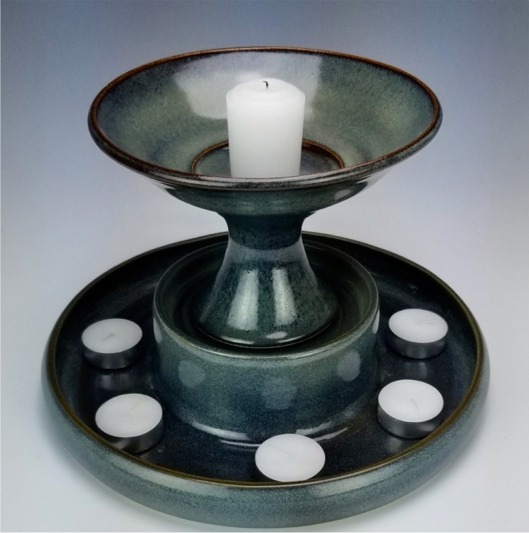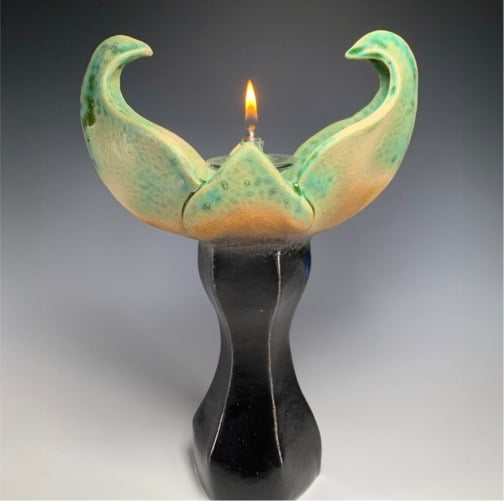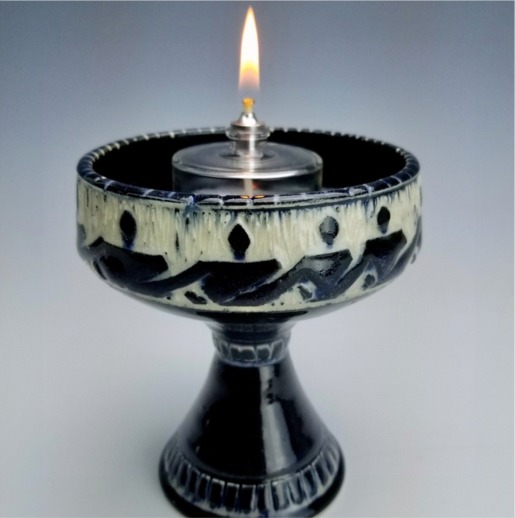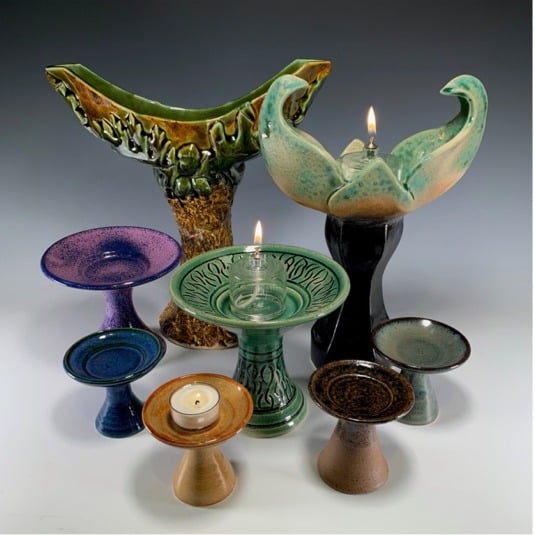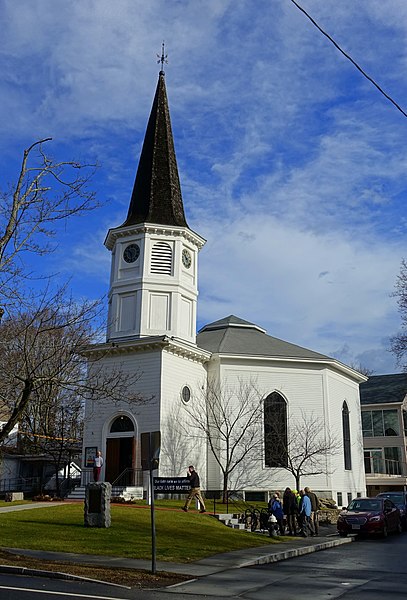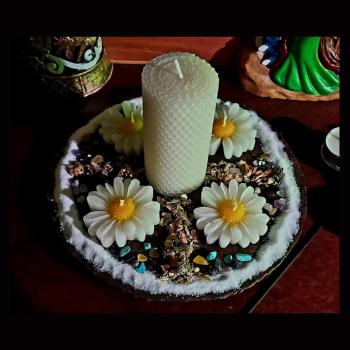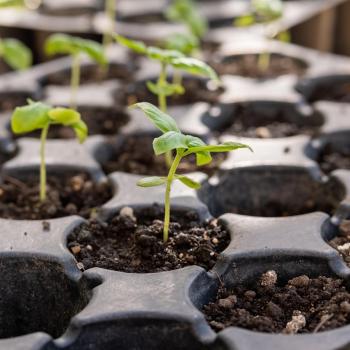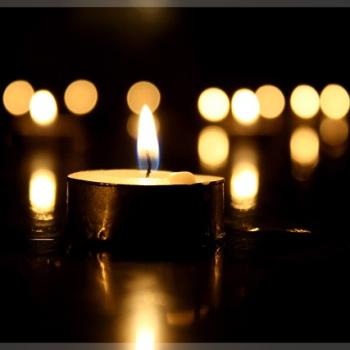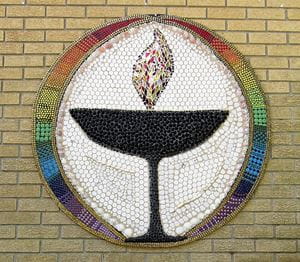
Religion Behind the Scenes spotlights the less discussed, but no less crucial, tasks that keep religious communities running, and the people who make it all happen.
Since World War II—in one form or another—the “flaming chalice” has been a symbol of the Unitarian tradition. In 1961, the Unitarian and Universalist faiths combined, but the original emblem (created by Austrian artist Hans Deutsch) continued to serve as the primary symbol of the newly combined faiths.
Kat Rose—of flamingchalice.com—has been making unique and handcrafted chalices for Unitarian Universalist churches and homes for decades. Through her artistic gifts and beautiful chalices, she has been blessing the lives of practitioners of Unitarian Universalism for many, many years. In this installment of Religion Behind the Scenes, we’ll learn a bit about flaming chalices, what they symbolize, how they are used, and what “religion” means for practitioners of the Unitarian Universalist tradition.
I’ve heard lots of different interpretations about what the flaming chalice represents, why it's important, and what it symbolizes. What can you tell us about that?
Some have waxed poetic about what the flaming chalice stands for. For example, there's the cup, which can represent inclusivity, in that all things can go into it. There's the flame of truth or of justice. In congregations, the chalice is traditionally elevated on a pedestal, reminding us to get out of the worldly and be elevated for a little while. These are all common interpretations.
Of course, it's not any kind of Voodoo or magic. The chalice doesn't “do” anything. It's just a symbol. Many Unitarian Universalist [U. U.] congregations light a chalice at the beginning of their services, or various meetings—at board meetings, women's group meetings, etc. Someone will light a flame in a chalice and say some words, like a little poem or a quote, or something like that. And then, at the end of the meeting, someone will extinguish the flame. It's just to remind us that, during this time—bracketed by lighting and extinguishing the chalice flame—we’re there to be in community and to support each other in our challenges and questions. That's one of the taglines of the Unitarian Universalist tradition: “We're not a church of answers. We're a church of questions.” So, the flaming chalice reminds us of the importance of being a community that supports each other in our challenges and questions.
The most beloved part of a Unitarian Universalist service is when people get up and share “joys” and “concerns.” Kind of like the Quakers do, people can just stand up and share anything they want to: a job landed or lost, their dog had puppies last week, or they lost their dog of 13-years and they’re heartbroken, or anything else. (People kind of stay away from politics, you know. It’s an unwritten rule.) They share personal things—the good and the bad—and people don't just listen but, afterwards, approach each other and say, “I’m sorry” or “congratulations.” So, it’s a real community-building thing.
Usually, we also light a small candle when we stand up and share. Everyone lights a little candle and adds it to a bowl so that all of those candles—kind of representing all of our combined joys and all of our combined sorrows—burn together during the service. It’s really beautiful and highlights the community aspect of our faith.
How long have you been involved in making chalices?
I took my first clay class around 1993 or 1994, and I’ve been making various things out of fired clay ever sense. It was probably somewhere between 1995 and 2000 when I started making chalices.
Back then, people would typically make them by creating the bowl part, and then make the pedestal part, and then kind of stick them together while the clay was still wet. But I noticed that you just can’t quite get the necessary symmetry that way. So, I learned this technique of how to make them so that the pedestal and the ball were always straight.
It was intimidating at first, working with some huge mass of clay. So I only made small chalices at first. I thought they were so cute. And so I made these little chalices and called them “personal chalices.” I took them to a district meeting, got a table, covered it with a cloth, and put out these 100 chalices I had made. I was shocked! People were lined up, and I sold out before lunch. After I had sold out, people were still coming up to me, asking, “Are you the person selling chalices?” So, I started taking orders, and it just grew from there. Little by little I got a website and, you know, just started making more and more. Now I make all kinds of chalices.
I get why you might want to try your hand at pottery. I’ve done a bit of that myself. But what drove you to make chalices instead of something else?
Mainly because I was a Unitarian. I'd look around our church building and we had things like flowerpots turned upside down (to be used as a chalice) or, you know, like a plain old candle holder instead of a chalice. So, I just kind of took it as a personal challenge to try to make proper chalices.
As I mentioned, I stared out making really small ones, and then I started making bigger ones. And then people wanted ones for the front of the sanctuary at their church. That introduced various design issues. The top can’t be too big, for example, or else it'll topple over, you know. When you start making bigger and bigger ones, they start looking like birdbaths or giant martini glasses, or something. So, I just started trying to design ones that were narrower and would look like the Unitarian Universalist official logo. It was quite a challenge to do that, because there were a lot of pieces that had to be stuck together. There were lots of challenges that had to be overcome, but (over time) I’ve really perfected the design and the process.
What are you most proud of in all of this? Is it a specific chalice you've made? Some design? The process of discovery that you've just described? What would you say you’re most proud of?
This won’t be what you would expect. I come from a science background, with a biochemistry degree. I just love science and I love lab work. I love the “potions” part—the mixing and measuring and weighing of stuff. And so, for me, the part I’m “proud of” would be making unique glazes for the outside of the chalices. I'm a chemist, and I like the glaze development process. From a personal point of view, it’s like my happy place doing glazed chemistry. I love getting to do that and playing with lots of different glazes. What really delights me is like, “Oh, look at that purple glaze with sparkles. I'm gonna try to make that!” you know? I love doing that.
Also, when I'm forming the chalices, and I do a lot of custom orders for churches, I'm always aware that this object that I'm making is going to be playing an important role in people's lives or a community's life. I often think about that as I make a chalice for a church or person.
I'm glad you opened that door, talking about the sacred side of what you do. When I saw your website, I wondered if there was a spiritual side for you in making these chalices. What can you tell us about that?
You know, when I am making these, and I am preparing to glaze a bunch of them in various colors, I will sometimes think about the fact that eventually each of these chalices will to “live” with someone. I mean, I can't say that I'm in some kind of “spiritual trance” when I’m doing that, you know. But where I really feel the spiritual side is in the custom work. Churches will get in touch with me to make a custom chalice for their congregation—and I love the process of doing that. For example, there's a church up in Massachusetts, where Ralph Waldo Emerson was the Unitarian minister. It’s a white octagonal shaped building called The Follen Community Church. It’s very unusual. They wanted a brand-new chalice, so they commissioned me to make it for them. So, I made an octagonal chalice that would match the building. As I was making that chalice, I found myself thinking of their lore and reading Emerson’s writings, and I kind of got immersed in all of it. That was definitely a spiritual component to my work.
I've made lots of chalices for sanctuaries over the years. And sometimes a congregation just wants to pick one from what I already have in stock, like, “I’ll take the blue one.” And sometimes they really want something specific—a name on it or a unique design. I love challenges like that. One Unitarian Universalist minister in Florida said to me, “I don't have a congregation, but I perform beach weddings.” She said, “I want a heavy duty, wide bottomed sturdy chalice that I can put on a little table at the beach—where the wind won’t blow it over.” And so that was just a great challenge. I mean, I love it when people give me those kinds of requests—and then give me enough time to really work on it. In this case, I really had to noodle around with what this would look like. It is for beach weddings, so what are the colors gonna be, you know? So, I made it with beach colors, tan and light turquoise. It had a distinct beach theme.
And, you know, I love for people to have a beautiful chalice instead of some old flowerpot with a candle in it. And, the funny thing is, I have lots of experiences where a piece didn’t come out the way I wanted it to, or I didn't really like it when it was done. And then it's the first thing that someone buys because, for them, it's like, “Oh, look at that beautiful thing.” So, beauty is definitely in the eye of the beholder. I feel like it's kind of like in Harry Potter, where “you don't choose the wand, but the wand chooses you.” It can be that way with chalices as well.
How does it feel to know that what you do is not only a center of attention for worshipers in Unitarian Universalist churches throughout the world, but also in the homes of individuals—where what you’ve created is enhancing their spirituality?
I do think about that all the time. I mean, I'm just so lucky to have found my way here. I feel like it's my service to the Unitarian Universalist community. Making chalices is my personal “ministry,” it's what I do to support my community. Just before our interview, I got an email from a minister. He was one of my first customers. He buys like 15 or 20 chalices from me every year. He gives them out freely. He gives them to all new members of his congregation. During the pandemic, their meetings were held via Zoom, and he wanted everyone to have a chalice in their home. He said it's so gratifying to see everybody pull out one of these chalices and hold it up for everyone else to see as they try to retain the idea of community during a time when they can’t physically meet together. I just love that.
I got a call one day from an old older lady. She said, “I am on your website, and I really love this one chalice, but I've never ordered anything online. And, you know, I'm afraid to do it.” So, I said, “No problem. I operate on the honor system. Just tell me which one you want, and I'll ship it to you. Then I'll send you a bill and you can just pay with PayPal.” She responded, “I don't know what that is.” So, I told her, “After the chalice arrives, assuming you like it, then just put a check in the mail.” So, I sent her the chalice and, sometime later, I received a little note from her with her shaky handwriting, along with the check. The note said that she had picked that specific chalice for her husband's memorial. She wanted it to be lit at his memorial, and then she could take it home and always remember him. And then she said, “This is the first check I've ever written in my life because I got married when I was young, and my husband always took care of the money. And I don't know anything. Thank you for being so kind.” You know, these things really do mean something to people. Those kinds of experiences are powerful to me.
Setting aside the pandemic, do Unitarian Universalists traditionally light chalices in their homes?
Yeah. For example, some people have a tradition of lighting a chalice before meals, and then family members might say what their “highs” or “lows” for that day were—or whatever their dinner ritual is. Again, nothing's required. It's not part of any kind of dictated practice. People will use chalices in a variety of ways in their personal lives and in their homes.
What’s the most common thing, positive or negative, that you run into in the work that you do?
The positive is that I get to make everything unique, which suits my personality. I'm sort of a dilettante. I like to research. I like to study things. I've got lots of things going on. So, it just suits my personality. There are some pottery makers that I know that have been making the same work, the exact same items, for 40 years. I couldn't do that. I mean, their work is beautiful, and they're skilled. But, for me, I love making unique things, making lots of different things.
Is there an element in what you do that might surprise people?
Yeah, how much cleaning you have to do! Making pottery is really messy. I mean, people will ask, “How long did it take you to make this chalice?” And it's like, “Well, you know, that chalice maybe only took me an hour to make.” But what isn’t added into that hour is the design time, the time it gook to invent the glaze, the making of it once you’ve invented it, the firing of the chalice, the cleaning of the containers, floors, and cleaning myself off. Having a clay studio is quite a bit of work. It takes a lot more time to make one of these when you include all of the details.
What else should people know about Unitarian Universalists and the chalices they use?
There's lots of art in the world and, you know, art stirs emotions. I love to be part of creating art for Unitarian Universalists—art that might “take one’s breath away,” or something that could make you look at the craftsmanship and think, “That's beautiful!” That, to me, is the highest praise I can get, and I want there to be more of that kind of art in the world.
It's interesting that one of the criticisms of the U. U. faith is that there's not enough spirituality, that it is all about social justice and what's happening in the world—"righting the wrongs of the world.” There is very little praying, contemplation, or anything like that. So that's the one criticism I've heard a lot. It's like, “When are you guys going to get around to the church part?” But I think a lot of people, like me, go to the beach, go hiking in the woods, or go to a beautiful place and sit and get renewed and refreshed. And certainly, going to “services” is a great way to connect with people. But I have always seen it as a social thing, rather than a religious thing. We focus heavily on what we call the “Seven Principles”—which are normative for how we live our lives:
1st Principle: The inherent worth and dignity of every person;
2nd Principle: Justice, equity and compassion in human relations;
3rd Principle: Acceptance of one another and encouragement to spiritual growth in our congregations;
4th Principle: A free and responsible search for truth and meaning;
5th Principle: The right of conscience and the use of the democratic process within our congregations and in society at large;
6th Principle: The goal of world community with peace, liberty, and justice for all;
7th Principle: Respect for the interdependent web of all existence of which we are a part.
I live by those seven principles, and I think about them a lot, because they’ve helped me make really important decisions in my life. These Seven Principles are what it means to be a Unitarian Universalist. These are our religion. I actually think Unitarian Universalism is the way of the future; I mean, with all of the discord, and the hate, and this horrible schism that we have in the world right now. The Unitarian Universalists are just saying, “Hey, why don't we all get along?”
The thing about being a Unitarian Universalist is that you can keep your old traditions from a previous religion, and even still go to church in another tradition. If you want to alternate and go take communion at the Catholic Church, and then come to the U.U. Church, you can do that. It's like, whatever is going to make you ask the right questions; that’s what’s right for you. We don't have dogma, there's no book that's ours alone. We source from all the different sources, you know—the Qur’an, the Bible—and we'll look for gems of wisdom in all of them. I mean, there are pagan Unitarian Universalists, humanist ones. There are Bible reading Unitarian Universalists, and Unitarians that are much more Christian based. So, there's lots of different ways you can be a U.U. It's like, we're all seeking, we're all trying to be good people, you know. And we're all walking each other home. Division is something we try to avoid. We’re much more about emphasizing unity and community.
Interview conducted, transcribed, edited, and condensed by Alonzo L. Gaskill.
ABOUT ALONZO L. GASKILL, PH.D.
Alonzo L. Gaskill is an author, editor, theologian, lecturer, and professor of World Religions. He holds degrees in philosophy, theology/comparative religion, and biblical studies. He has authored more than two-dozen books and numerous articles on various aspects of religion; with topics ranging from world religions and interfaith dialogue, to scriptural commentaries, texts on symbolism, sacred space, and ritual, and even devotional literature.
7/13/2022 10:01:33 PM
